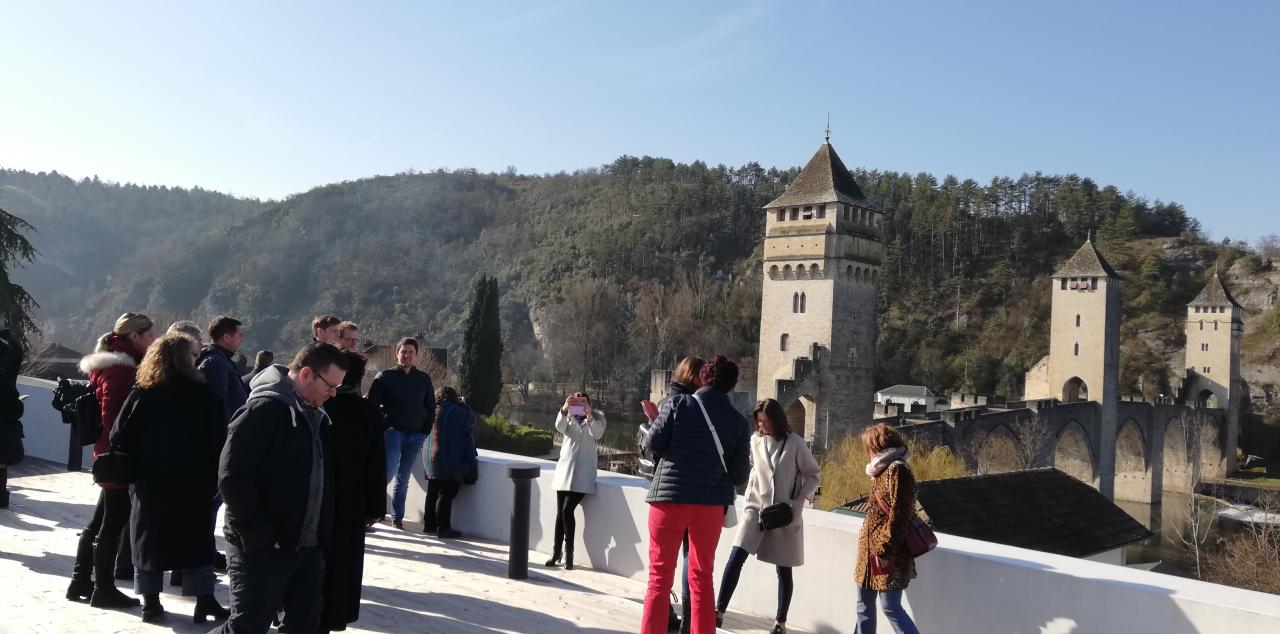
A few minutes after flying over the Pyrenees, the plane starts its descent to Toulouse airport, the nearest destination to Cahors, one of the small European cities participating in the INT-HERIT project. This project involves and gives name to a network of 9 cities, all committed to the improvement of heritage management at local level as a way of connecting it to their future. In Cahors, the traveller soon discovers the weight of heritage and how for both political representatives and citizens, it is perhaps one of the most important assets when it comes to recovering the centrality of the city for the future, as it was in the past.
At the hotel room, the newcomer is welcomed by different publications that encourage reading and confirm the appreciation by Cahor’s people of history, its narrative and its value as a point from which to reinvent the future of the territory.
Some words escape from the beautifully illustrated texts and outline the concepts and ideas that will accompany the visit. Ville, agglomération, coeur, mise en valeur, strategy ... No matter the language in which they are written, they all speak of organised, committed, open political action aiming at regaining that space of lost centrality to which our hosts will refer again and again.
The Pont Valentré stands witness to this flow of history as well as of water. Regardless of the time of the day, be it dawn or nightfall, this true icon of the city is a unique setting to get immersed in the evocative atmosphere that connects the dreams of the past with the vision of the future. The members of the INT-HERIT transnational network were invited to this discovery and it is therefore time to raise the curtain and show the stage.

The landscapes of the Lot and the construction of the territory
Without leaving the city, and as an appetiser, here is an original presentation of how the landscape of this territory has evolved, by Mathieu Larribe, landscape architect and director of the “Conseil d'Architecture, d'Urbanisme et de l'Environnement du Lot”. After this first immersion in geology, nature and cultural heritage, it is time to go for a walk.
The “ville de Cahors” was founded by the Romans inside an extensive meander, constricted by the nearby hills and its steep slopes. This location around a river with meanders every step of the way is not surprising, as the traveller will discover moving from Cahors towards Puy-l'Evêque. Not far from that village, recalling a renowned and powerful bishop, Clos Triguedina's wine cellar offers to satisfy thirst and hunger. In its origin, the place was a frequent stop for pilgrims walking towards Santiago de Compostela, calling here to ask for supplies with the wording “me trigo de dina”, which in the Occitan language means "I look forward to dinner".
The scenery spreads across successive alluvial terraces where several thousand hectares are dedicated to wine cultivation, excelling the production of the Malbec grape, the hallmark of Cahors wines. There are charming postcards, panoramas full of contrasts, colour, distant horizons and vines sculpted by time and the pruning of the winegrowers. All that happens in the middle of the always omnipresent Lot and its groves, as green guards planted on its banks.
Actually, Cahors is located at a historic crossroads, hence its relevance as a commercial and business site, growing in importance throughout the Middle Ages thanks to the river traffic since the 13th century and the power of the local Bishops and the religious orders profusely represented in the city.
The 19th century brought, after the Revolution, the closure of numerous religious foundations while different public and cultural institutions and industries came to occupy those empty buildings. Banks, cafés and businesses colonised the new open boulevards, leading to a period of modernisation in which there was no shortage of infrastructures, including hospitals or the arrival of the railway.
Nonetheless, the French Department of Lot, where Cahors is located, is one of the least populated in the country and also has a widely dispersed population, which reinforces the problems associated with this type of habitat, characterised by an enormous number of small urban centres scattered throughout the territory while Cahors exhibits, despite its small population (20,062 inhabitants), the only truly urban imprint within the Lot geographical area.

A strategy to fight against the population exodus and the loss of position
Since the end of the 19th century, different events contributed to the decline of Cahors and the important role played by this city in the previous centuries. The phylloxera crisis, the industrial revolution or the transport crisis caused a rural exodus that has lasted over time and affected Cahors deeply.
Even though there is a dense network of roads and highways crossing the territory, the fall of river transport has not been alleviated in Cahors by railways and road infrastructure, generally deficient over decades and only partially improved in recent years.
The topographical conditions or the absence of industry, together with the aforementioned circumstances, have led to keeping the monumental centre inhabited, although with some difficulties related to habitability and accessibility to the dwellings located in this area. This has caused a certain abandonment and a loss of economic activity.
Aware of the need, once again, to "rebuild the city on the city", the municipality in collaboration with “Grand Cahors” - a federation of 36 municipalities with Cahors at its centre - launched in 2008 the strategy "Cahors, Coeur d'Agglo", aimed at enhancing the whole of the municipality focusing on its core, by trying to avoid the common desertification that historical centres have suffered in many small and medium European cities.
Laure Courget, Director of the Department of Heritage in the City of Cahors, points out the main lines that define the evolution of the Historical centre and in particular one of its most emblematic streets, the Rue Château du Roi.
From the very heart of the historic city, the aforementioned strategy proposes a series of inter-connected actions:
- Restoration of architectural heritage and improvement of housing habitability
- Enhancement of public space
- Regeneration of economic activity, promotion of the retail sector
- Sustainable mobility policy
- Support for the installation of infrastructures (multiplex cinema)
- Development of emblematic projects (4 star Hotel, International Youth Hostel, Renovation of the Henri-Martin Museum, Renovation of the University Campus ...)
The URBACT method applied to Cahors sustainable urban development
European cooperation is another ingredient that both the municipality and the Grand Cahors are using well in order to improve their capabilities when it comes to responding to their urban challenges. Cahors’ participation in the INT-HERIT Project, under the URBACT III Programme is proving to be a success.
Local participation is essential to URBACT and the city has been able to take advantage of this method when promoting a stakeholders’ group that is involved in the collective generation of answers to the problems experienced by the urban centre, exemplified in the Château-du-Roi street. Indeed, an original urban laboratory is underway in Cahors. In a wider area of the urban centre (Château du Roi street, Liberation Square, Portal Alban Street and nearby streets), the population and institutions have been mobilised together with other actors and professionals through a study group baptised as ULG Cahors ( Urbact Local Group).
This ULG is a space for dialogue, exchange and co-construction for the future of the Château-du-Roi street. Bringing together members with different interests, the Group allows to cross the approaches, the needs, the practices and to co-create about the uses of the assets. This Group is coordinated by a technical team from Grand Cahors, that aligns the Department of Tourism, the Projects Department and the Regional Planning Department. The development of the Group takes place during the meetings, through the intervention of the heads of these departments who translate into field work what they have learned recently in a training on participatory approaches.
Public-private cooperation is also among the implementation challenges linked to the urban development plans of the associated cities in URBACT transnational networks. Thus, the intervention promoted in the urban centre of Cahors is playing this card. A good example is the private rehabilitation of the building located at number 72, Château-du-Roi street. On this occasion, the participatory work has also contributed to a better implementation of a private rehabilitation project by pointing towards different technical solutions and proposals aimed at introducing the public use of some of the spaces in this private building.
In the general context of the renovation of the urban centre, and in addition to the actions already mentioned, some others are of special interest. One of them is located right at the epicentre of the Château-du-Roi street, where the Palais de Via is located. A large building from the 14th century, with a profile of important volumes highlighted by a monumental tower, this palace is known as the Château du Roi. From the period of the Revolution its function was redefined and some decades later it was housing a state prison, this until the year 2012. Since then, new lines are being written in the story of this historic building. The municipal commitment is clear, promoting a strategy that allows the joint action of the state, the city and the private sector in a wide sense, creating a multi purpose space for residential, cultural, tourist and other uses. The participants in the INT-HERIT Transnational Seminar have had the opportunity to contribute their ideas to the renovation plans for this symbolic building, as well as regarding the Château-du-Roi street intervention.
The international cooperation initiatives promoted by the municipality of Cahors and the Grand Cahors do not end here. Suffice it to mention the active participation in the celebration of the two editions of the “Biennale Européenne des Patrimoines”, or the leadership of the ENERPAT Project within the framework of the INTERREG Sudoe Programme. In the latter, together with the cities of Porto and Vitoria, Cahors seeks to identify co-creative solutions for energy efficiency in the residential buildings of the historic centres.
These are some of the rehabilitation examples that illustrate the commitment of the municipality to the revitalization of this ancient city, a necessary impulse where originality and beauty are not lacking. Small and beautiful details also shine in this new renaissance of the city, like the twenty Secret Gardens, designed to occupy with life and beauty small abandoned corners of the old urban centre. The city dresses in green, making up its contemporary face with the color of hope.

